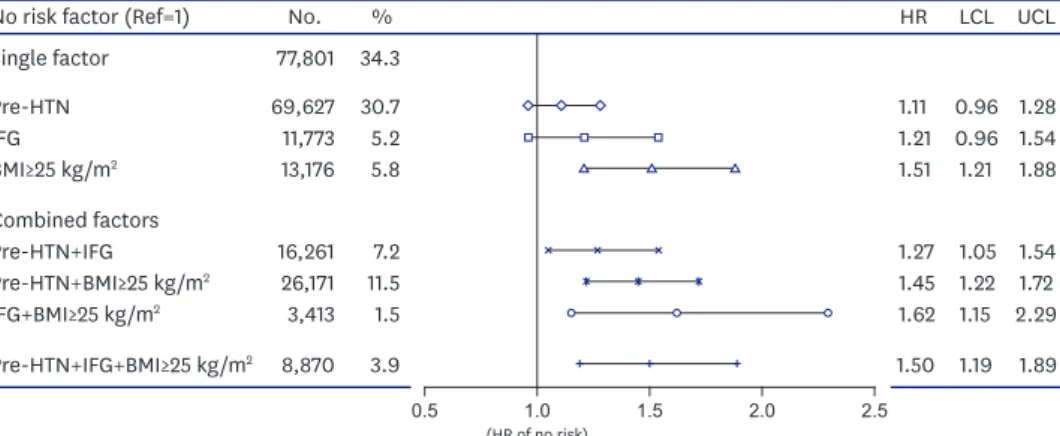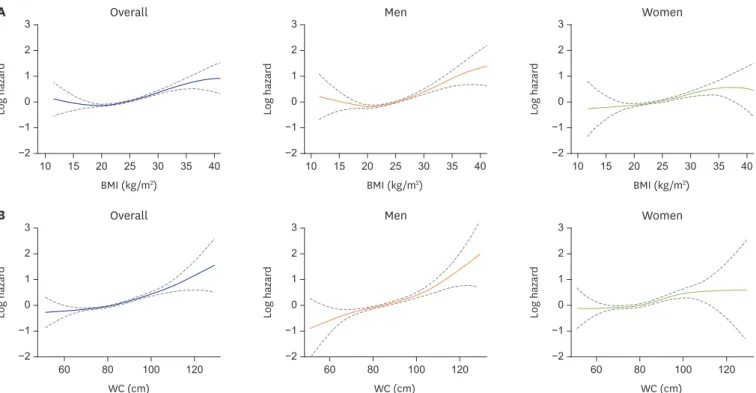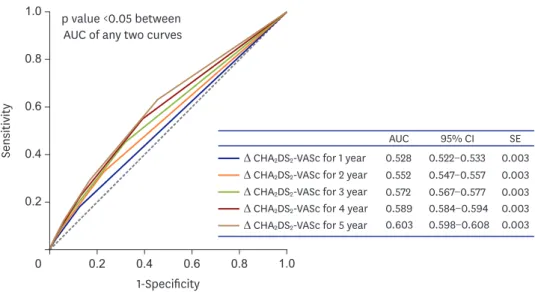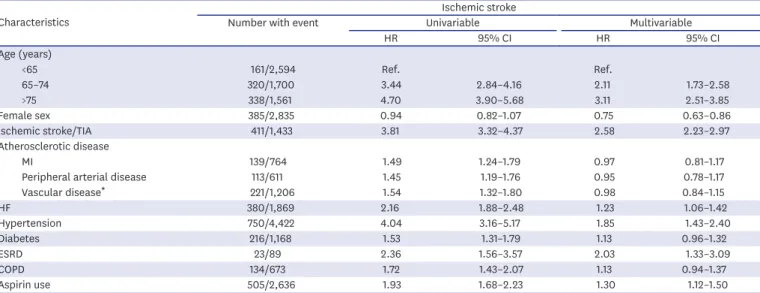Risk Factor Management for Atrial Fibrillation
전체 글
(2) Risk Factors of AF. HYPERTENSION Hypertension is highly prevalent in the adult population with AF, especially among persons older than 60 years, and affects approximately 1 billion adults worldwide.1)2)8) According to the Seventh Report of the Joint National Committee on Prevention, Detection, Evaluation and Treatment of High Blood Pressure guidelines, 62.2% of Korean patients with AF had hypertension.9) After applying the 2017 American College of Cardiology/American Heart Association guidelines for hypertension, 79.4% had hypertension, adding 17.2% cases as newly re-defined hypertension (130–139/80–89 mmHg). The Korean population with hypertension (hazard ratio [HR], 1.80; 95% confidence interval [CI], 1.62–1.99; p<0.001) had an increased risk of new-onset AF (Table 1).5) Hypertension and pre-hypertension are independently associated with AF.10)11) Indeed, AF can be considered a manifestation of target organ damage due to hypertension.. Table 1. Baseline characteristics and risk of atrial fibrillation Characteristics Number (n=171,324) HR* (95% CI) p value Sex Female 67,142 1 Male 104,182 1.65 (1.49–1.82) <0.001 Age (years) 40–49 100,269 1 50–59 47,917 1.67 (1.49–1.87) <0.001 60–69 19,215 3.60 (3.19–4.07) <0.001 70–79 3,923 5.04 (4.18–6.06) <0.001 BMI (kg/m2) <18.5 3,141 1.10 (0.87–1.39) 0.97 18.5–19.9 9,322 1.06 (0.84–1.35) 0.93 20.0–22.4 41,575 1 22.5–24.9 59,984 1.03 (0.91–1.17) 0.60 ≥25.0 57,302 1.24 (1.10–1.41) <0.001 Hypertension No 113,929 1 Yes 57,395 1.80 (1.62–1.99) <0.001 DM No 156,609 1 Yes 14,715 0.95 (0.83–1.10) 0.53 Dyslipidemia No 123,995 1 Yes 47,329 1.12 (1.02–1.24) 0.01 MI No 169,470 1 Yes 1,584 1.60 (1.17–2.18) <0.003 Excessive alcohol intake (≥5 times/week) No 165,296 1 Yes 6,028 0.99 (0.80–1.22) 0.99 Excessive exercise (≥5 times/week) No 160,315 1 Yes 11,009 0.95 (0.80–1.12) 0.55 Heavy smoking (≥30 pack-years) No 153,404 1 Yes 19,374 1.10 (0.96–1.26) 0.13 BMI = body mass index; CI = confidence interval; DM = diabetes mellitus; HR = hazard ratio; MI = myocardial infarction. *HRs were adjusted for clinical variables including age, sex, initial BMI, hypertension, diabetes mellitus, dyslipidemia, excessive alcohol intake (drinking ≥5 times/week), excessive exercise (exercise ≥5 times/week), and heavy smoking (smoking ≥30 pack-years).. https://e-kcj.org. https://doi.org/10.4070/kcj.2019.0212. 795.
(3) Risk Factors of AF. What is the ideal blood pressure treatment threshold for atrial fibrillation? The presence of hypertension in patients with AF has been identified to be an independent risk factor for stroke, increasing the risk by 1.8- to 2-fold compared with that in the absence of hypertension. Uncontrolled high blood pressure enhances the risk of stroke and bleeding events and may lead to recurrent AF.12) Therefore, good blood pressure control should form an integral part of the management of patients with AF, as a component of the holistic approach to AF management.7) However, the optimal blood pressure treatment threshold for patients with AF with hypertension has not been well identified. Two recent studies suggested that blood pressure should be more strictly controlled in patients with AF.9)11) Patients with newly re-defined hypertension had a greater risk of major cardiovascular events (HR, 1.07; 95% CI, 1.05–1.10), ischemic stroke (HR, 1.12; 95% CI, 1.08– 1.16), intracranial hemorrhage (HR, 1.12; 95% CI, 1.01–1.23), and admission for heart failure (HR, 1.06; 95% CI, 1.01–1.11) than non-hypertensive patients (<130/80 mmHg).9) In patients with AF under hypertension treatment, a U-shaped relationship for major cardiovascular events was evident, with 120–129/<80 mmHg as the optimal blood pressure treatment target (Figure 1). The benefit-to-harm ratio of optimal blood pressure control (120–129/<80 mmHg) relative to suboptimal blood pressure control (130–139/80–89 mmHg) was >1.00 for all subgroups stratified by the 10-year cardiovascular disease risk (<10%, 10–20%, and >20%), suggesting that patients with AF with treated hypertension would have greater benefit than harm from optimal blood pressure control regardless of the estimated cardiovascular disease risk (Figure 2).9). Effect of hypertension duration on ischemic stroke risk in atrial fibrillation The increase of hypertension duration was associated with an increased risk of ischemic stroke. A 1-year increase of hypertension duration continuously increased the adjusted risk of ischemic stroke until 7 years and reached a plateau with an adjusted HR of 1.6. The risk of ischemic stroke linearly increased with the increase of hypertension duration in patients aged. 1.3. 1.0. 1.6. (Reference). Intracranial hemorrhage. 1.0. 1.3. 1.4 1.2. 0.8. 1.1. 0.9. <120/80 120–129 130–139 ≥140/90 /<80 /80–89. 1.0. 1.2. (Reference). <120/80 120–129 130–139 ≥140/90 /<80 /80–89. (Reference). Myocardial infarction. 1.1. 0.9. (Reference). <120/80 120–129 130–139 ≥140/90 /<80 /80–89. Ischemic stroke. 1.2 1.1 1.0 0.9. <120/80 120–129 130–139 ≥140/90 /<80 /80–89. 1.2. 1.0. 1.3. HR (95% CI). 1.1. Death from all-causes. 1.3. HR (95% CI). HR (95% CI). 1.2. 0.9. HR (95% CI). Major cardiovascular event. HR (95% CI). HR (95% CI). 1.3. (Reference). <120/80 120–129 130–139 ≥140/90 /<80 /80–89. Heart failure admission. 1.2 1.1 1.0 0.9. (Reference). <120/80 120–129 130–139 ≥140/90 /<80 /80–89. Figure 1. Risk of adverse outcomes according to blood pressure. CI = confidence interval; HR = hazard ratio.. https://e-kcj.org. https://doi.org/10.4070/kcj.2019.0212. 796.
(4) Risk Factors of AF. Korean AF cohort. Benefit-to-harm ratio. 3.0. *. 2.5 *. 2.0 1.5. *. 1.0 0.5 0. <10%. 10–20%. >20%. 10-year CVD risk Figure 2. Benefit-to-harm ratios of optimal (120–129/<80 mmHg) versus suboptimal blood pressure control (130–139/80–89 mmHg) according to 10-year predicted cardiovascular risk subgroups. AF = atrial fibrillation; CVD = cardiovascular disease. *If a p value is less than 0.05, it is flagged with one star.. <65 years, whereas the risk reached a plateau in those aged ≥65 years (Figure 3). In all baseline and pre-AF average systolic blood pressure subgroups, a longer duration of hypertension before AF was associated with a higher ischemic stroke risk than a shorter duration of hypertension.13) However, this long-term effect of hypertension duration can be attenuated by long-term strict systolic blood pressure control throughout the entire duration of hypertension. The effect of long-term hypertension was not observed in patients with strictly well-controlled pre-AF average systolic blood pressure of <120 mmHg (Figure 4).13). DIABETES Diabetes and AF frequently coexist because of their associations with other risk factors. Diabetes is a risk factor for stroke and other complications in AF.2)14) In patients with AF, a longer duration of diabetes seems to confer a higher risk of thrombo-embolism, albeit without a greater risk of oral anticoagulant (OAC)-related bleeding.15) An impaired fasting glucose (IFG) is a prior stage to diabetes, which is a well-known risk factor for AF. Because IFG is common worldwide and is considered clinically normal, treatments for this condition are rare. Lee et al.11) reported that in healthy Asian populations without comorbidities, IFG and pre-hypertension were important risk factors for AF. Subjects with IFG (HR, 1.16) had a higher risk of AF, and diastolic blood pressure (HR, 1.11) was a stronger indicator for the occurrence of AF than systolic blood pressure. As the risks IFG, pre-hypertension, and body mass index (BMI) ≥25 kg/m2 increased, the risk of AF also increased. Even in a healthy population, subjects with all 3 risks had a much higher AF risk (HR, 1.50) than those without. IFG related to AF was more prominent in subjects with BMI <25 kg/m2 (HR, 1.18) than in those with BMI ≥25 kg/m2, and subjects with both IFG and pre-hypertension had a greater AF risk (HR, 1.27) than those without (Figure 5).11) The BMIdependent effects of pre-hypertension and IFG also showed a similar pattern for AF-related stroke, HF, and mortality in a healthy population.11). https://e-kcj.org. https://doi.org/10.4070/kcj.2019.0212. 797.
(5) Risk Factors of AF. HR (95% CI). 2.5. B. Age <55 years. 3.0. HR (per 1-year increase) 0.99 (0.96–1.02). HR (per 1-year increase) 1.06 (1.00–1.12). 2.0 1.5. 0.5. 0.5 6. 8. 10. 12. 2. 14. Duration of hypertension (year). HR (95% CI). 2.5. D. Age 65–74 years. 3.0. HR (per 1-year increase) 1.03 (1.01–1.05). HR (per 1-year increase) 1.00 (0.98–1.03). 1.5. 0.5. 0.5 8. 10. 10. 12. 14. 12. HR (per 1-year increase) 1.08 (1.06–1.10). HR (per 1-year increase) 0.98 (0.96–1.00). 1.5 1.0. 6. 8. 2.0. 1.0. 4. 6. Age ≥75 years. 3.0 2.5. 2.0. 2. 4. Duration of hypertension (year). HR (95% CI). C. HR (per 1-year increase) 1.04 (1.01–1.08). 1.5 1.0. 4. HR (per 1-year increase) 1.04 (1.02–1.06). 2.0. 1.0. 2. Age 55–64 years. 3.0 2.5. HR (95% CI). A. 2. 14. Duration of hypertension (year). 4. 6. 8. 10. 12. 14. Duration of hypertension (year). Figure 3. Duration of hypertension and risk of ischemic stroke in patients with AF according to different age categories. (A) Age <55 years. (B) Age 55–64 years. (C) Age 65–74 years. (D) Age ≥75 years. Patients with hypertension duration under 1 year are used as reference. AF = atrial fibrillation; CI = confidence interval; HR = hazard ratio.. A Pre-AF average SBP <120 mmHg HTN duration Non-hypertensive HTN with duation <3 years HTN with duation 3 to 5 years HTN with duation ≥5 years. No. of patients 13,067 12,706 3,516 10,001. No. of events 368 603 221 766. Rate (95% CI) 3.17 (2.85–3.51) 5.70 (5.26–6.18) 7.76 (6.77–8.85) 10.29 (9.58–11.05). Adjusted HR (95% CI) Ref 1.11 (0.97–1.28) 1.03 (0.84–1.26) 1.18 (1.00–1.39) 0.8. 1.0 1.3 HR (95% CI). p value for trends <0.01. 2.0. B Pre-AF average SBP 120–139 mmHg HTN duration Non-hypertensive HTN with duation <3 years HTN with duation 3 to 5 years HTN with duation ≥5 years. No. of patients 13,067 30,596 12,940 48,233. No. of events 368 1,811 989 4,469. Rate (95% CI) 3.17 (2.85–3.51) 7.17 (6.84–7.50) 9.66 (9.06–10.28) 12.78 (12.40–13.16). Adjusted HR (95% CI) Ref 1.38 (1.22–1.55) 1.53 (1.33–1.76) 1.64 (1.46–1.86) 0.8. 1.0 1.3 HR (95% CI). p value for trends <0.01. 2.0. Figure 4. Risk of ischemic stroke according to the duration of hypertension in patients with AF. (A) Baseline SBP <120 mmHg. (B) Baseline SBP 120–139 mmHg. AF = atrial fibrillation; CI = confidence interval; HR = hazard ratio; HTN = hypertension; SBP = systolic blood pressure.. https://e-kcj.org. https://doi.org/10.4070/kcj.2019.0212. 798.
(6) Risk Factors of AF. No risk factor (Ref=1). No.. %. Single factor. 77,801. 34.3. HR. Pre-HTN IFG BMI≥25 kg/m2. 69,627 11,773 13,176. 30.7 5.2 5.8. 1.11 0.96 1.28 1.21 0.96 1.54 1.51 1.21 1.88. Combined factors Pre-HTN+IFG Pre-HTN+BMI≥25 kg/m2 IFG+BMI≥25 kg/m2. 16,261 26,171 3,413. 7.2 11.5 1.5. 1.27 1.45 1.62. 1.05 1.54 1.22 1.72 1.15 2.29. Pre-HTN+IFG+BMI≥25 kg/m2. 8,870. 3.9. 1.50. 1.19. 0.5. 1.0. (HR of no risk). 1.5. 2.0. LCL UCL. 1.89. 2.5. Figure 5. Incidence and risk of AF based on the combination of risk factors. AF = atrial fibrillation; BMI = body mass index; HR = hazard ratio; HTN = hypertension; LCL = lower confidence limit; IFG = impaired fasting glucose; UCL = upper confidence limit.. OBESITY Obesity is linked to AF and is considered a conventional risk factor for adverse cardiovascular events.16-19) Large epidemiological studies have observed strong associations between obesity and the incidence of AF and AF-related complications.16-19) Obesity is associated with an increased left atrial size and a decreased left ventricular diastolic function, which, in turn, leads to an increased left atrial pressure.18) In addition, dynamic changes in left atrial size and pressure likely affect both the atrial substrate and the triggers for AF.17) In the Korean population, a high BMI (≥25 kg/m2; HR, 1.24; 95% CI, 1.10–1.41) was associated with a greater AF risk compared with a BMI of 20–22.5 kg/m2 (Table 1).5) Waist circumference and waist-to-hip circumference ratio are also associated with a higher risk of AF.20) Visceral adiposity is associated with incident cardiovascular disease after adjustment for clinical risk factors and generalized adiposity.21) The prevalence of overweight and obesity is much lower in Asian populations than in Western populations.1)19) Baek et al.19) showed that abdominal obesity is an important, potentially modifiable risk factor for AF in non-obese Asians. After multivariable adjustment, each 1 standard deviation (3.7 kg/m2 and 9.4 cm) increase in BMI or waist circumference was associated with an increase of 8% (p<0.001) and 12% (p<0.001), respectively. Spline curves between BMI and waist circumference, and the HR of new-onset AF are presented in Figure 6. A nonlinear J-shaped association was found between continuous BMI variables and AF risk. AF risk positively increased with the increase of waist circumference. Interestingly, the overall J-shaped and linear patterns in the association seem to be mainly driven by the patterns for men. Abdominal obesity was associated with new-onset AF in the underweight (p<0.001), normal (p<0.001), and overweight (p<0.001) groups, but not in the obese group (p=0.894). These data suggest that interventions to decrease abdominal obesity may reduce the population burden of AF.19). https://e-kcj.org. https://doi.org/10.4070/kcj.2019.0212. 799.
(7) Risk Factors of AF. Overall. 3. 1 0 −1. 2. 1 0 −1. 10. 15. 20. 25. 30. 35. −2. 40. 10. 15. 25. 30. 35. −2. 40. Men. 0 −1 100. WC (cm). 120. 1 0. −2. 20. 25. 30. 35. 40. Women. 2. −1 80. 15. 3. Log hazard. 1. 60. 10. BMI (kg/m2). 2. Log hazard. Log hazard. 20. 3. 2. −2. 0. BMI (kg/m2). Overall. 3. 1. −1. BMI (kg/m2). B. Women. 3. 2. Log hazard. Log hazard. 2. −2. Men. 3. Log hazard. A. 1 0 −1. 60. 80. 100. WC (cm). 120. −2. 60. 80. 100. 120. WC (cm). Figure 6. Spline curves between BMI and WC, and the HR of new-onset AF. Although there was a non-linear J-shaped association between continuous BMI variables and AF risk (A), the AF risk increased positively as WC increased (B). AF = atrial fibrillation; BMI = body mass index; HR = hazard ratio; WC = waist circumference.. WEIGHT FLUCTUATION The use of baseline weight or BMI measurements alone cannot capture the dynamic BMI changes that may influence the incidence of AF.17) Patients in the normal or underweight BMI category may experience undesired weight loss due to other medical problems, which may affect the incidence of AF in the general population.22) The Atherosclerosis Risk in Communities study found that a weight loss or gain of >5% of the initial body weight was positively associated with AF.22) In addition, the LEGACY study reported incremental increases in AF burden with weight fluctuations.23) In the underweight and normal Asian population, BMI variability, especially weight gain, increased the risk of incident AF and MI but not the risk of stroke.5) Figure 7 shows the incidence of new-onset AF, MI, ischemic stroke, and cardiovascular death per 1,000 personyears according to BMI variability. In initially underweight and normal individuals (initial BMI <25 kg/m2), the highest BMI variability (Q4) was associated with a significantly higher incidence of AF than a stable BMI variability (Q1). Furthermore, the highest BMI variability, especially weight gain, was related to higher systolic and diastolic blood pressure, fasting blood glucose level, and total cholesterol level than those with a more stable BMI variability. The Korean population with dyslipidemia (HR, 1.12; 95% CI, 1.02–1.24; p=0.01) had an increased risk of new-onset AF (Table 1).5) This finding suggests that avoiding weight fluctuation, especially weight gain, is important to prevent AF and to decrease the risk of MI in the underweight and normal Asian populations.5). https://e-kcj.org. https://doi.org/10.4070/kcj.2019.0212. 800.
(8) Risk Factors of AF. A. B. New-onsest AF *. *. 4 3 2 1 0. Q1 Q2 Q3 Q4. Overall. C. Q1 Q2 Q3 Q4. BMI<25. Q1 Q2 Q3 Q4. 2.0 1.5 1.0 0.5 0. Q1 Q2 Q3 Q4. D. Ischemic stroke. *. *. Overall. Q1 Q2 Q3 Q4. BMI<25. 8. *. *. 6 4 2. Q1 Q2 Q3 Q4. Overall. Q1 Q2 Q3 Q4. BMI<25. Q1 Q2 Q3 Q4. Q1: ASV<0.5. BMI≥25. *. *. 1.5. *. 1.0 0.5 0. BMI≥25. Q2: 0.5≤ASV<1.0 Weight gain. Q1 Q2 Q3 Q4. Cardiovascular death 2.0. Incidence rate (per 1,000 PY). Incidence rate (per 1,000 PY). 2.5. BMI≥25. 10. 0. Myocardial infarction 3.0. Incidence rate (per 1,000 PY). Incidence rate (per 1,000 PY). 5. Q1 Q2 Q3 Q4. Overall. Q3: 1.0≤ASV<1.5 Weight loss. Q1 Q2 Q3 Q4. BMI<25. Q1 Q2 Q3 Q4. BMI≥25. Q4: ASV≥1.5. Figure 7. Incidence rate according to BMI variability. New-onset AF (A), MI (B), ischemic stroke (C), and cardiovascular death (D). Q1: ASV<0.5; Q2: 0.5≤ASV<1.0; Q3: 1.0≤ASV<1.5; Q4: ASV≥1.5. AF = atrial fibrillation; ASV = average successive variability; BMI = body mass index; MI = myocardial infarction. *Asterisks indicate that there is a significant difference between overall Q1 and Q4 (p<0.05).. MYOCARDIAL INFARCTION AF is a common arrhythmia of acute MI (AMI) that has been shown to be related to increased in-hospital and long-term mortality rates.24) Various pathologic mechanisms including elevated left ventricular end-diastolic pressure, increased atrial pressures, acute deterioration of left ventricular function, left atrial enlargement, atrial ischemia, or infarction can contribute to the development of AF in the AMI setting.24) Inflammatory markers, mainly C-reactive protein, have been reported to be related to future AF development.25)26) Accordingly, Hwang et al.27) reported that C-reactive protein could be strongly related to early AF in patients with AMI, especially in those with a less dilated left atrium. In addition to being an established complicating factor for MI, recent studies have revealed that AF increased the risk of MI.28) Lee et al.29) reported that AF was associated with a 3-fold increased risk of MI (HR, 3.1; 95% CI, 2.22–4.37) in both men (HR, 2.91; 95% CI, 1.91–4.45) and women (HR, 3.52; 95% CI, 2.01–6.17) (Figure 8). The risk of AF-associated MI was higher in patients free of hypertension, diabetes, ischemic stroke, and dyslipidemia at baseline. The cumulative incidence of AF-associated MI was lower in patients under anticoagulant and https://e-kcj.org. https://doi.org/10.4070/kcj.2019.0212. 801.
(9) Risk Factors of AF. B. 4. AF No AF Log-rank p<0.001. 2. 0. 10. 20. 30. 40. 50. 60. 2,583 10,371. 1,552 6,218. 1,448 6,155. Time (month) Number at risk AF 3,295 No AF 13,159. 3,273 13,136. 3,173 12,676. 2,986 11,785. Incidence rate per 1,000 person-year. Cumulative incidence (%). A. 10. AF No AF. 2.88*. 8 3.12*. 3.65*. All. Women. 6 4 2 0. Men. Figure 8. AF and MI. (A) Cumulative incidence of MI related to AF in the propensity scored-matched cohort. (B) Age-adjusted incidence rate and incidence rate ratios of MI. AF = atrial fibrillation; MI = myocardial infarction. *If a p value is less than 0.05, it is flagged with one star.. statin treatments. This finding suggests that that AF complications beyond stroke should extend to total mortality to include MI.29). AIR POLLUTION Epidemiological studies have suggested that exposure to elevated levels of ambient particulate matter (PM) <2.5 μm (PM2.5) or <10 μm (PM10) in aerodynamic diameter is consistently associated with adverse cardiac events.30-33) Although many studies for these adverse cardiovascular outcomes have been performed, the correlations between short-term exposures to PM2.5 and incident AF were uncertain.34) However, these studies were performed in the European countries and United States, where the air pollution levels are much lower than in Asian countries. Therefore, the effect sizes could be low in those studies. Kim et al.35) reported that long-term exposure to PM2.5 (HR 1.18 for 10 μg/m3 increments, p<0.001) and PM10 (HR 1.03 for 10 μg/m3 increments, p<0.001) is associated with an increased incidence of new-onset AF in the Asian general population (Figure 9). It is more profound in obese male subjects older than 60 years and in those with a history of hypertension or previous MI.35). PREDICTION OF STROKE RISK Stroke prevention is the principal management priority in patients with AF, given its association with a 5-fold increase in stroke risk.3)15)36) The CHA2DS2-VASc score is now used in most guidelines for stroke prevention in patients with AF.3)15) The adjusted incidence rates (per 100 person-years) of ischemic stroke were 3.79 in Korea, being 0.26 in low-risk patients (CHA2DS2-VASc score 0 [men] or 1 [female]), 1.18 in intermediate-risk patients (CHA2DS2VASc score 1 [men]), and 5.30 in high-risk patients (CHA2DS2-VASc ≥2).2) The more recent focus of stroke prevention in patients with non-valvular AF has shifted away from predicting “high-risk” patients toward initially identifying patients at a “truly low-risk” of ischemic https://e-kcj.org. https://doi.org/10.4070/kcj.2019.0212. 802.
(10) Risk Factors of AF. B. 1.4. 1.12. 1.3. 1.09. 1.2. 1.06. HR. HR. A. 1.1. 1.03. 1.0 0. 1.00 20. 25. 30. 0. 40. 35. 40. 60. 50. PM2.5 (µg/m3). 70. 80. PM10 (µg/m3). Figure 9. Concentration-response relationships between incident AF and long-term exposures to air pollution. (A) PM2.5. (B) PM10. AF = atrial fibrillation; HR = hazard ratio; PM2.5 = particulate matter <2.5 μm; PM10 = particulate matter <10 μm.. stroke in whom OAC has no net clinical benefit.8) Korean patients who were categorized as “low-risk” by the CHA2DS2-VASc score (i.e., score of 0 point in men or 1 point in female) consistently had an event rate of <1%/year.2) Stroke risk as assessed by the CHA2DS2-VASc score is dynamic and changes over time. The rates of ischemic stroke increased when patients accumulated risk factors and were reclassified into higher CHA2DS2-VASc score categories. Assessment of stroke risk is needed at every patient contact, as accumulation of risk factors with increasing CHA2DS2-VASc score translates to greater stroke risks over time (Figure 10).14). 1.0. p value <0.05 between AUC of any two curves. Sensitivity. 0.8. 0.6. 0.4. ∆ CHA2DS2-VASc for 1 year ∆ CHA2DS2-VASc for 2 year ∆ CHA2DS2-VASc for 3 year ∆ CHA2DS2-VASc for 4 year ∆ CHA2DS2-VASc for 5 year. 0.2. 0. 0.2. 0.4. 0.6. 0.8. AUC. 95% CI. SE. 0.528 0.552 0.572 0.589 0.603. 0.522−0.533 0.547−0.557 0.567−0.577 0.584−0.594 0.598−0.608. 0.003 0.003 0.003 0.003 0.003. 1.0. 1-Specificity Figure 10. ROC curves of delta CHA2DS2-VASc scores in predicting ischemic stroke. AUC = area under the curve; CI = confidence interval; ROC = receiver operating characteristic; SE = standard error.. https://e-kcj.org. https://doi.org/10.4070/kcj.2019.0212. 803.
(11) Risk Factors of AF. Female sex In Koreans, the risk of incident AF was higher in men than in women (HR, 1.65; 95% CI, 1.49–1.82) (Table 1).5) On multivariable analysis, significant associations between CHA2DS2VASc risk factors and ischemic stroke were observed; however, the significance of vascular disease or diabetes mellitus was attenuated after multivariable adjustment, and female sex (HR, 0.73; 95% CI, 0.64–0.84) had a lower risk of ischemic stroke than male sex (Table 2).2)37) Several cohort studies have shown that female sex is a risk factor for stroke, albeit dependent on age.38)39) Recently, female sex was suggested as a risk modifier for stroke in patients with AF.40) However, Asian cohort studies have indicated that female sex was not an independent risk factor for ischemic stroke, again suggesting some potential ethnic differences in the risk of stroke between Asian and non-Asian populations.3) Consistent with previous Asian studies, female sex was not a risk factor for stroke in a Korean cohort; instead, it was associated with a lower stroke risk of ischemic stroke than that of male sex.2)37). Age threshold The risk of incident AF was increased with advancing age (Table 1).5) Older age is also the most important risk factor for ischemic stroke in AF among the 7 individual risk factors included in the CHA2DS2-VASc score, particularly for low- to intermediate-risk patients.41-43) However, the appropriate age threshold (e.g., CHA2DS2-VASc score, 1 point for age 65–74 years, 2 points for age ≥75 years) is still controversial, as actual age thresholds may differ between different countries and ethnic groups. Moreover, the ability of a risk scoring scheme to identify patients with AF who are at a “truly low-risk” of stroke is even more important in Asians because the stroke risk among Asian populations may be much higher than that among Western populations.44-47) Older age is the most important predictor of ischemic stroke in Korean and Taiwan patients with AF.43)48) Patients aged 65–74 years without other risk factors showed a significantly higher risk of stroke than those with 1 risk factor other than age. Lowering the current age threshold (age ≥65 years) in the CHA2DS2-VASc score to age ≥55 years might be appropriate in Asian patients with AF.43) Table 2. Associations between baseline factors and ischemic stroke in patients without anticoagulant treatment4) Ischemic stroke Characteristics Number with event Univariable Multivariable HR 95% CI HR 95% CI Age (years) <65 161/2,594 Ref. Ref. 65–74 320/1,700 3.44 2.84–4.16 2.11 1.73–2.58 >75 338/1,561 4.70 3.90–5.68 3.11 2.51–3.85 Female sex 385/2,835 0.94 0.82–1.07 0.75 0.63–0.86 Ischemic stroke/TIA 411/1,433 3.81 3.32–4.37 2.58 2.23–2.97 Atherosclerotic disease MI 139/764 1.49 1.24–1.79 0.97 0.81–1.17 Peripheral arterial disease 113/611 1.45 1.19–1.76 0.95 0.78–1.17 Vascular disease* 221/1,206 1.54 1.32–1.80 0.98 0.84–1.15 HF 380/1,869 2.16 1.88–2.48 1.23 1.06–1.42 Hypertension 750/4,422 4.04 3.16–5.17 1.85 1.43–2.40 Diabetes 216/1,168 1.53 1.31–1.79 1.13 0.96–1.32 ESRD 23/89 2.36 1.56–3.57 2.03 1.33–3.09 COPD 134/673 1.72 1.43–2.07 1.13 0.94–1.37 Aspirin use 505/2,636 1.93 1.68–2.23 1.30 1.12–1.50 CI = confidence interval; COPD = chronic obstructive pulmonary disease; ESRD = end-stage renal disease; HF = heart failure; HR = hazard ratio; MI = myocardial infarction; TIA = transient ischemic attack. *Vascular disease includes previous MI, peripheral arterial disease, or aortic plaque.. https://e-kcj.org. https://doi.org/10.4070/kcj.2019.0212. 804.
(12) Risk Factors of AF. CONCLUSION The management of diseases (obesity, hypertension, heart failure, diabetes mellitus, sleep apnea) related to AF should be provided continuously, whereas lifestyle factors such as smoking and drinking should be monitored in an integrated manner.3) However, in lean Asian populations, strict blood pressure control and management of IFG should be emphasized. Avoiding abdominal obesity and weight fluctuation, as well as controlling the exposure to air pollution might reduce the development of AF. Finally, female sex is not a risk factor for stroke in Asian populations. Lowering the current age threshold (age ≥65 years) in the CHA2DS2-VASc score to age ≥55 years might be appropriate in Asian patients with AF. Knowledge of these factors and their management will enable optimal management and can improve the outcome of patients with AF.. REFERENCES 1. Lee H, Kim TH, Baek YS, et al. The trends of atrial fibrillation-related hospital visit and cost, treatment pattern and mortality in Korea: 10-year nationwide sample cohort data. Korean Circ J 2017;47:56-64. PUBMED | CROSSREF. 2. Kim TH, Yang PS, Uhm JS, et al. CHA2DS2-VASc score (congestive heart failure, hypertension, age >/=75 [doubled], diabetes mellitus, prior stroke or transient ischemic attack [doubled], vascular disease, age 65–74, female) for stroke in Asian patients with atrial fibrillation: A Korean nationwide sample cohort study. Stroke 2017;48:1524-30. PUBMED | CROSSREF. 3. Joung B, Lee JM, Lee KH, et al. 2018 Korean guideline of atrial fibrillation management. Korean Circ J 2018;48:1033-80. PUBMED | CROSSREF. 4. Kim D, Yang PS, Yu HT, et al. Risk of dementia in stroke-free patients diagnosed with atrial fibrillation: data from a population-based cohort. Eur Heart J 2019;40:2313-23. PUBMED | CROSSREF. 5. Lim YM, Yang PS, Jang E, et al. Body mass index variability and long-term risk of new-onset atrial fibrillation in the general population: a Korean nationwide cohort study. Mayo Clin Proc 2019;94:225-35. PUBMED | CROSSREF. 6. Mazurek M, Shantsila E, Lane DA, Wolff A, Proietti M, Lip GY. Guideline-adherent antithrombotic treatment improves outcomes in patients with atrial fibrillation: insights from the community-based Darlington atrial fibrillation registry. Mayo Clin Proc 2017;92:1203-13. PUBMED | CROSSREF. 7. Lip GY. The ABC pathway: an integrated approach to improve AF management. Nat Rev Cardiol 2017;14:627-8. PUBMED | CROSSREF. 8. Kim TH, Yang PS, Kim D, et al. CHA2DS2-VASc score for identifying truly low-risk atrial fibrillation for stroke: a Korean nationwide cohort study. Stroke 2017;48:2984-90. PUBMED | CROSSREF. 9. Kim D, Yang PS, Kim TH, et al. Ideal blood pressure in patients with atrial fibrillation. J Am Coll Cardiol 2018;72:1233-45. PUBMED | CROSSREF. 10. Schnabel RB, Yin X, Gona P, et al. 50 year trends in atrial fibrillation prevalence, incidence, risk factors, and mortality in the Framingham Heart Study: a cohort study. Lancet 2015;386:154-62. PUBMED | CROSSREF. 11. Lee SS, Kong KA, Kim D, et al. Clinical implication of an impaired fasting glucose and prehypertension related to new onset atrial fibrillation in a healthy Asian population without underlying disease: a nationwide cohort study in Korea. Eur Heart J 2017;38:2599-607. PUBMED | CROSSREF. 12. Manolis AJ, Rosei EA, Coca A, et al. Hypertension and atrial fibrillation: diagnostic approach, prevention and treatment. Position paper of the Working Group ‘Hypertension Arrhythmias and Thrombosis’ of the European Society of Hypertension. J Hypertens 2012;30:239-52. PUBMED | CROSSREF. https://e-kcj.org. https://doi.org/10.4070/kcj.2019.0212. 805.
(13) Risk Factors of AF. 13. Kim TH, Yang PS, Yu HT, et al. Effect of hypertension duration and blood pressure level on ischaemic stroke risk in atrial fibrillation: nationwide data covering the entire Korean population. Eur Heart J 2019;40:809-19. PUBMED | CROSSREF. 14. Yoon M, Yang PS, Jang E, et al. Dynamic changes of CHA2DS2-VASc score and the risk of ischaemic stroke in Asian patients with atrial fibrillation: a nationwide cohort study. Thromb Haemost 2018;118:1296-304. PUBMED | CROSSREF. 15. Kirchhof P, Benussi S, Kotecha D, et al. 2016 ESC Guidelines for the management of atrial fibrillation developed in collaboration with EACTS. Eur Heart J 2016;37:2893-962. PUBMED | CROSSREF. 16. Wang TJ, Parise H, Levy D, et al. Obesity and the risk of new-onset atrial fibrillation. JAMA 2004;292:2471-7. PUBMED | CROSSREF. 17. Tedrow UB, Conen D, Ridker PM, et al. The long- and short-term impact of elevated body mass index on the risk of new atrial fibrillation the WHS (Women's Health Study). J Am Coll Cardiol 2010;55:2319-27. PUBMED | CROSSREF. 18. Abed HS, Samuel CS, Lau DH, et al. Obesity results in progressive atrial structural and electrical remodeling: implications for atrial fibrillation. Heart Rhythm 2013;10:90-100. PUBMED | CROSSREF. 19. Baek YS, Yang PS, Kim TH, et al. Associations of abdominal obesity and new-onset atrial fibrillation in the general population. J Am Heart Assoc 2017;6:e004705. PUBMED | CROSSREF. 20. Frost L, Benjamin EJ, Fenger-Grøn M, Pedersen A, Tjønneland A, Overvad K. Body fat, body fat distribution, lean body mass and atrial fibrillation and flutter. A Danish cohort study. Obesity (Silver Spring) 2014;22:1546-52. PUBMED | CROSSREF. 21. Britton KA, Massaro JM, Murabito JM, Kreger BE, Hoffmann U, Fox CS. Body fat distribution, incident cardiovascular disease, cancer, and all-cause mortality. J Am Coll Cardiol 2013;62:921-5. PUBMED | CROSSREF. 22. Huxley RR, Misialek JR, Agarwal SK, et al. Physical activity, obesity, weight change, and risk of atrial fibrillation: the Atherosclerosis Risk in Communities study. Circ Arrhythm Electrophysiol 2014;7:620-5. PUBMED | CROSSREF. 23. Pathak RK, Middeldorp ME, Meredith M, et al. Long-term effect of goal-directed weight management in an atrial fibrillation cohort: a long-term follow-up study (legacy). J Am Coll Cardiol 2015;65:2159-69. PUBMED | CROSSREF. 24. Pedersen OD, Abildstrøm SZ, Ottesen MM, et al. Increased risk of sudden and non-sudden cardiovascular death in patients with atrial fibrillation/flutter following acute myocardial infarction. Eur Heart J 2006;27:290-5. PUBMED | CROSSREF. 25. Chung MK, Martin DO, Sprecher D, et al. C-reactive protein elevation in patients with atrial arrhythmias: inflammatory mechanisms and persistence of atrial fibrillation. Circulation 2001;104:2886-91. PUBMED | CROSSREF. 26. Malouf JF, Kanagala R, Al Atawi FO, et al. High sensitivity C-reactive protein: a novel predictor for recurrence of atrial fibrillation after successful cardioversion. J Am Coll Cardiol 2005;46:1284-7. PUBMED | CROSSREF. 27. Hwang HJ, Ha JW, Joung B, et al. Relation of inflammation and left atrial remodeling in atrial fibrillation occurring in early phase of acute myocardial infarction. Int J Cardiol 2011;146:28-31. PUBMED | CROSSREF. 28. Soliman EZ, Safford MM, Muntner P, et al. Atrial fibrillation and the risk of myocardial infarction. JAMA Intern Med 2014;174:107-14. PUBMED | CROSSREF. 29. Lee HY, Yang PS, Kim TH, et al. Atrial fibrillation and the risk of myocardial infarction: a nation-wide propensity-matched study. Sci Rep 2017;7:12716. PUBMED | CROSSREF. 30. Peters A, Dockery DW, Muller JE, Mittleman MA. Increased particulate air pollution and the triggering of myocardial infarction. Circulation 2001;103:2810-5. PUBMED | CROSSREF. 31. Brook RD, Rajagopalan S, Pope CA 3rd, et al. Particulate matter air pollution and cardiovascular disease: an update to the scientific statement from the American Heart Association. Circulation 2010;121:2331-78. PUBMED | CROSSREF. https://e-kcj.org. https://doi.org/10.4070/kcj.2019.0212. 806.
(14) Risk Factors of AF. 32. Kim IS, Sohn J, Lee SJ, et al. Association of air pollution with increased incidence of ventricular tachyarrhythmias recorded by implantable cardioverter defibrillators: vulnerable patients to air pollution. Int J Cardiol 2017;240:214-20. PUBMED | CROSSREF. 33. Sohn J, You SC, Cho J, Choi YJ, Joung B, Kim C. Susceptibility to ambient particulate matter on emergency care utilization for ischemic heart disease in Seoul, Korea. Environ Sci Pollut Res Int 2016;23:19432-9. PUBMED | CROSSREF. 34. Link MS, Luttmann-Gibson H, Schwartz J, et al. Acute exposure to air pollution triggers atrial fibrillation. J Am Coll Cardiol 2013;62:816-25. PUBMED | CROSSREF. 35. Kim IS, Yang PS, Lee J, et al. Long-term exposure of fine particulate matter air pollution and incident atrial fibrillation in the general population: a nationwide cohort study. Int J Cardiol 2019;283:178-83. PUBMED | CROSSREF. 36. Lip G, Freedman B, De Caterina R, Potpara TS. Stroke prevention in atrial fibrillation: past, present and future. Comparing the guidelines and practical decision-making. Thromb Haemost 2017;117:1230-9. PUBMED | CROSSREF. 37. Kang SH, Choi EK, Han KD, et al. Risk of ischemic stroke in patients with non-valvular atrial fibrillation not receiving oral anticoagulants - Korean nationwide population-based study -. Circ J 2017;81:1158-64. PUBMED | CROSSREF. 38. Friberg L, Benson L, Rosenqvist M, Lip GY. Assessment of female sex as a risk factor in atrial fibrillation in Sweden: nationwide retrospective cohort study. BMJ 2012;344:e3522. PUBMED | CROSSREF. 39. Mikkelsen AP, Lindhardsen J, Lip GY, Gislason GH, Torp-Pedersen C, Olesen JB. Female sex as a risk factor for stroke in atrial fibrillation: a nationwide cohort study. J Thromb Haemost 2012;10:1745-51. PUBMED | CROSSREF. 40. Nielsen PB, Skjøth F, Overvad TF, Larsen TB, Lip GY. Female sex is a risk modifier rather than a risk factor for stroke in atrial fibrillation: should we use a CHA2DS2-VA score rather than CHA2DS2-VASc? Circulation 2018;137:832-40. PUBMED | CROSSREF. 41. Chao TF, Liu CJ, Wang KL, et al. Should atrial fibrillation patients with 1 additional risk factor of the CHA2DS2-VASc score (beyond sex) receive oral anticoagulation? J Am Coll Cardiol 2015;65:635-42. PUBMED | CROSSREF. 42. Olesen JB, Lip GY, Hansen ML, et al. Validation of risk stratification schemes for predicting stroke and thromboembolism in patients with atrial fibrillation: nationwide cohort study. BMJ 2011;342:d124. PUBMED | CROSSREF. 43. Kim TH, Yang PS, Yu HT, et al. Age threshold for ischemic stroke risk in atrial fibrillation. Stroke 2018;49:1872-9. PUBMED | CROSSREF. 44. Siu CW, Lip GY, Lam KF, Tse HF. Risk of stroke and intracranial hemorrhage in 9727 Chinese with atrial fibrillation in Hong Kong. Heart Rhythm 2014;11:1401-8. PUBMED | CROSSREF. 45. Guo Y, Apostolakis S, Blann AD, et al. Validation of contemporary stroke and bleeding risk stratification scores in non-anticoagulated Chinese patients with atrial fibrillation. Int J Cardiol 2013;168:904-9. PUBMED | CROSSREF. 46. Chao TF, Lip GY, Liu CJ, et al. Validation of a modified CHA2DS2-VASc score for stroke risk stratification in Asian patients with atrial fibrillation: a nationwide cohort study. Stroke 2016;47:2462-9. PUBMED | CROSSREF. 47. Lip GY, Wang KL, Chiang CE. Non-vitamin K antagonist oral anticoagulants (NOACs) for stroke prevention in Asian patients with atrial fibrillation: time for a reappraisal. Int J Cardiol 2015;180:246-54. PUBMED | CROSSREF. 48. Chao TF, Wang KL, Liu CJ, et al. Age threshold for increased stroke risk among patients with atrial fibrillation: a nationwide cohort study from Taiwan. J Am Coll Cardiol 2015;66:1339-47. PUBMED | CROSSREF. https://e-kcj.org. https://doi.org/10.4070/kcj.2019.0212. 807.
(15)
수치
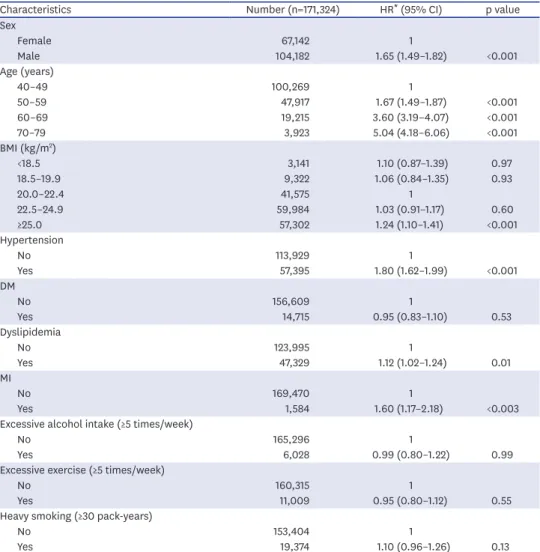
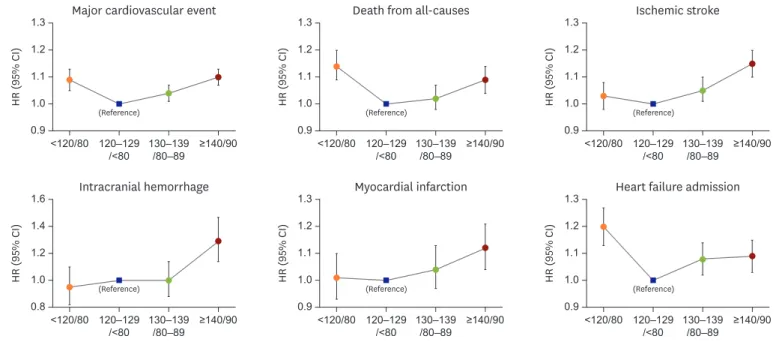
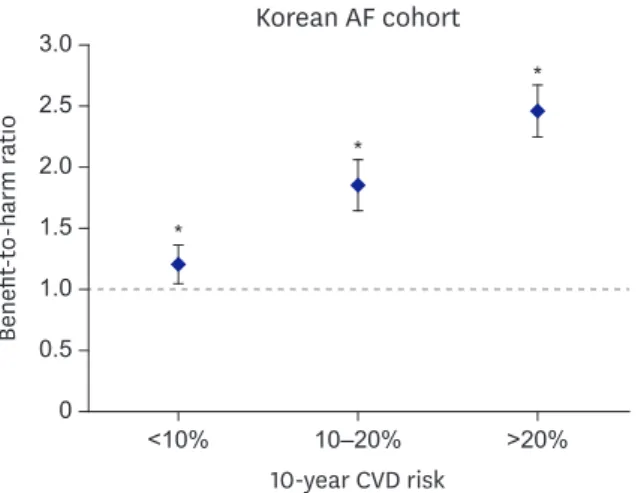
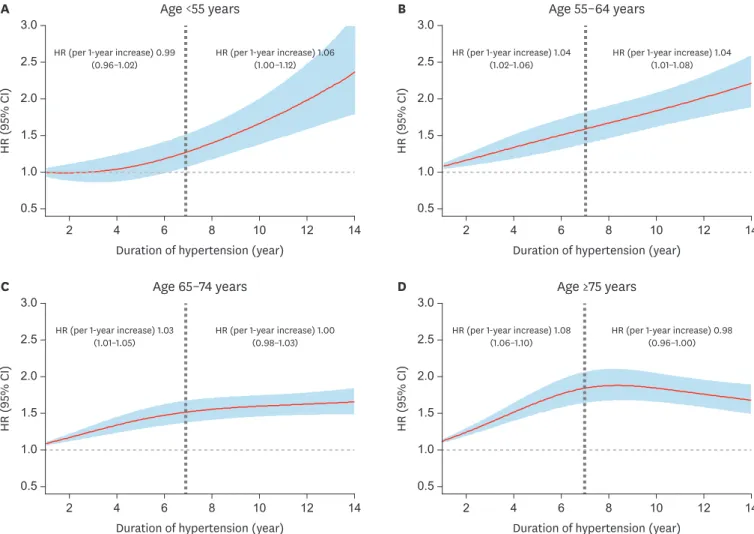
관련 문서
Objective :::: The neovascularization is an essential a factor for the growth of solid organ cancer, and especially vascular endothelial growth factor (VEGF)
지진동이 OBE 수준보다 작고 주요 설비에서 지진으로 인한 손상이 발생 되지 않은 것으로 확인된 경우 계속 운전9. 지진동이 OBE 수준을 초과하거나 주요 설비에서
First, as for the relationship between interest factor and self-esteem formation, human relation factor as an interest factor had a significant effect at
For example, the public’s sentiments of risk regarding nuclear power plants exceeds the risk felt by an expert in the area, and therefore the public sentiment is a negative
* 원천기술혁신은 새로운 문제, 이를 해결하기 위한 과학, 기술과 잠재적 시장에 대한 정보, 그리고 이를 수행하는 데 필요한 역량과 활동을 matching 시키는 매우
Risk Management and Decision
This study aims to identify whether socioeconomic level of parents affects obesity of adolescents and whether the relations between adolescent's obesity
For an electron, the magnetic moment is antiparallel to the orbital angular momentum, but proportional to it. For spin angular momentum, there is a factor 2, which
